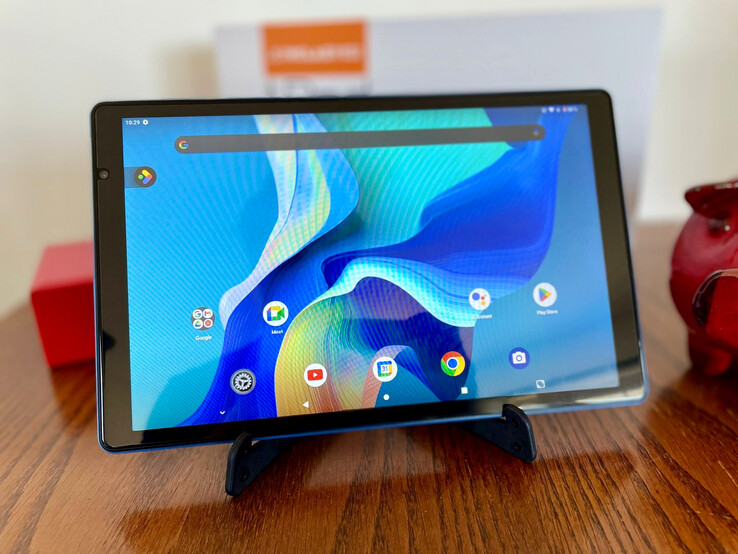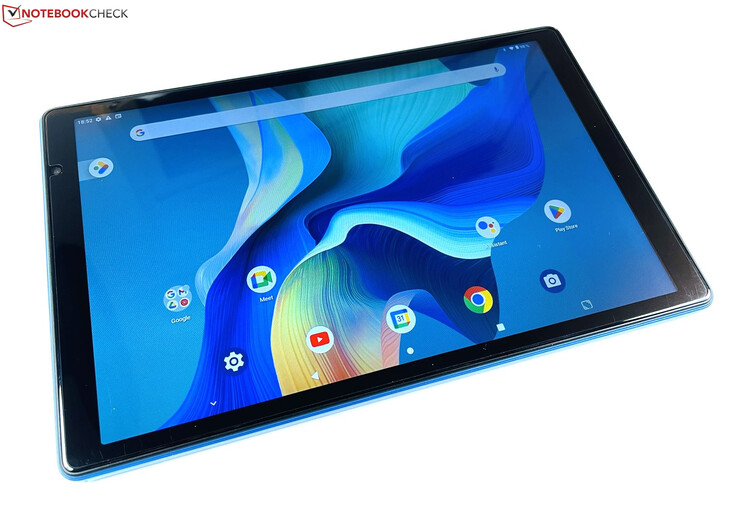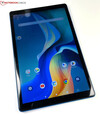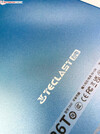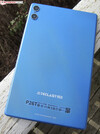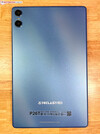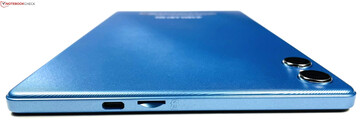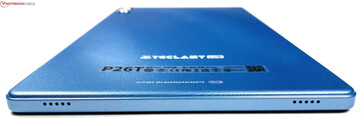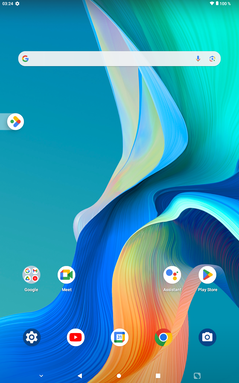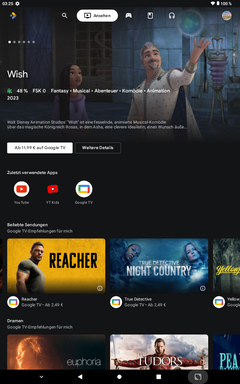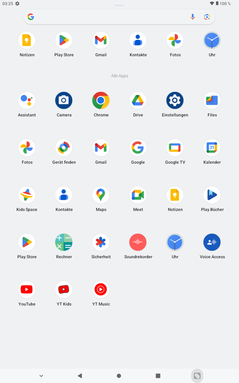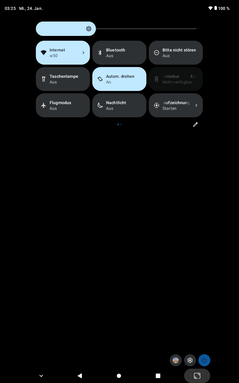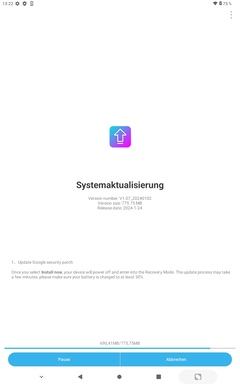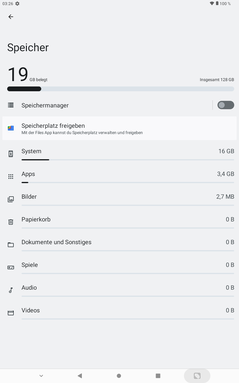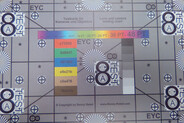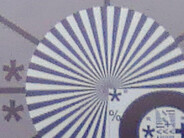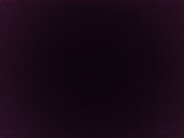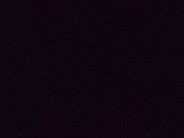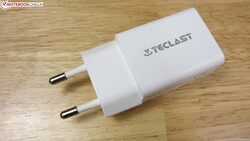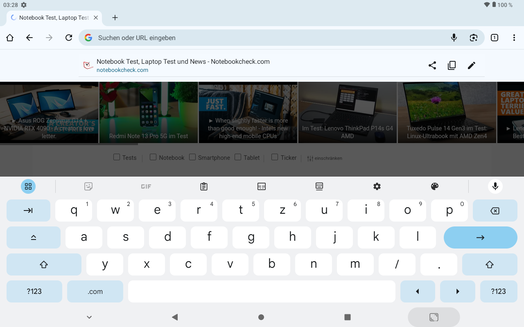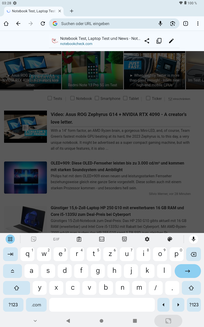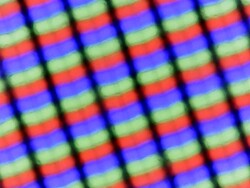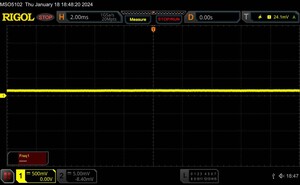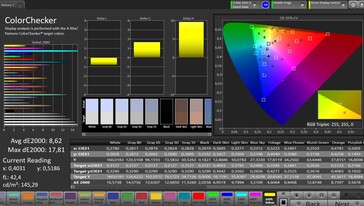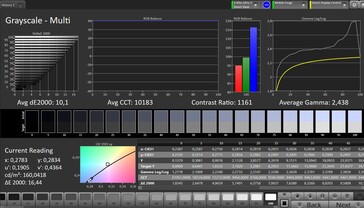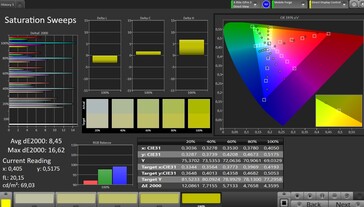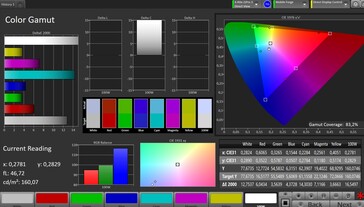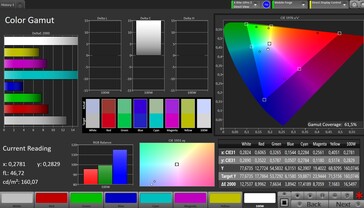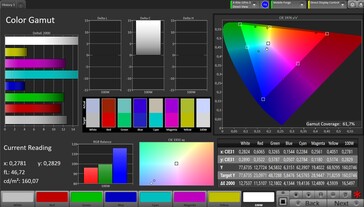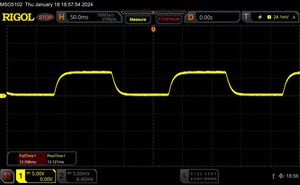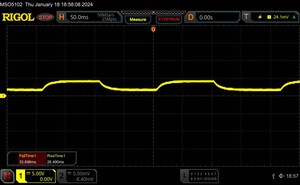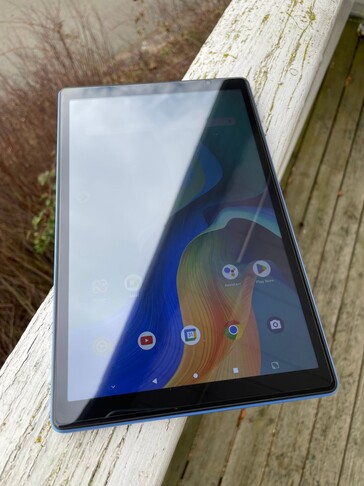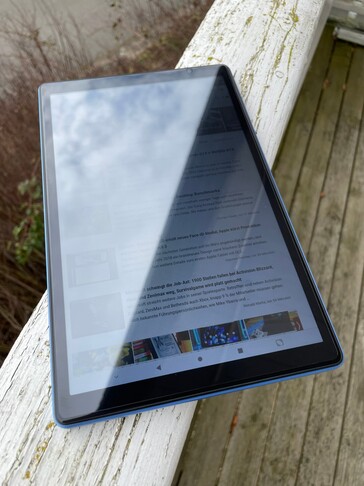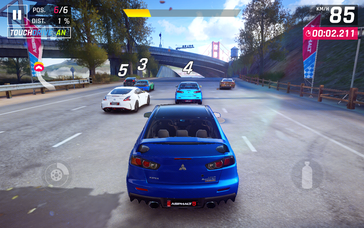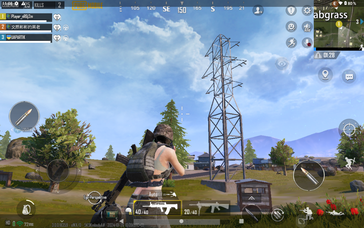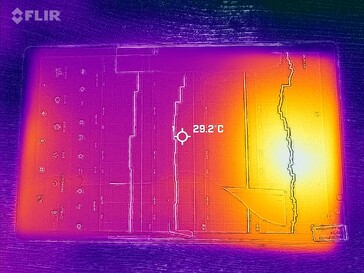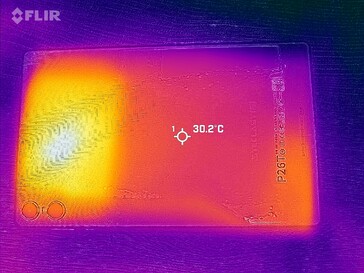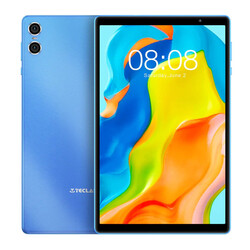Teclast P26T review - Opinions differ about the budget tablet
With the P26T, the Chinese manufacturer Teclast offers a very affordable Android tablet. Officially, the 10.1-inch tablet costs 100 US-Dollars and is available (in Germany) on Amazon, for example, where you can often get it for sale at even less than 100 Euros.
In budget tablets, some limitations on the performance, battery life, and display are often a given. But at first glance, the Teclast P26T offers fairly solid equipment with Android 13, the Allwinner A523 octa-core SoC, 4 GB of RAM, 128 GB storage, an IPS panel, and a 6000-mAh battery. Our test shows the actual capabilities of the Teclast P26T and for whom it might be a suitable tablet.
Possible Competitors in Comparison
Rating | Date | Model | Weight | Height | Size | Resolution | Price |
|---|---|---|---|---|---|---|---|
| 75.2 % v7 (old) | 02 / 2024 | Teclast P26T A523, Mali-G57 MP1 | 511 g | 10.2 mm | 10.10" | 1280x800 | |
| 80.4 % v7 (old) | 01 / 2024 | Blackview Tab 80 T7200 (T606), Mali-G57 MP1 | 484 g | 7.5 mm | 10.10" | 1280x800 | |
| 80 % v7 (old) | 03 / 2023 | Lenovo Tab M10 Gen 3 T610, Mali-G52 MP2 | 460 g | 8.5 mm | 10.10" | 1920x1200 | |
| 79.4 % v7 (old) | 01 / 2024 | Teclast M50 HD T7200 (T606), Mali-G57 MP1 | 435 g | 8 mm | 10.10" | 1920x1200 | |
| 81.2 % v7 (old) | 05 / 2023 | Samsung Galaxy Tab A7 LTE 2022 T618, Mali-G52 MP2 | 477 g | 7 mm | 10.40" | 2000x1200 | |
| 83.5 % v7 (old) | 01 / 2024 | Xiaomi Redmi Pad SE SD 680, Adreno 610 | 481 g | 7.36 mm | 11.00" | 1920x1200 |
Case - Blue plastic with a wave pattern
At 511 grams (~18 oz), the Teclast P26T weighs slightly more than similarly affordable comparison devices such as the Lenovo Tab M10 Gen 3. The display bezels aren't very small at 1.4 cm (~0.55 in) on the short and 0.8 cm (~0.31 in) on the long sides, but they help avoiding accidental inputs on the touchscreen. Teclast has chosen an unusual position for the selfie camera, which is placed to the left of the display below the top.
A bright blue back cover is the design characteristic of the Teclast P26T that stands out most. The matte back cover is textured with a wavy pattern that reflects the light in different ways depending on the viewing angle and looks fairly attractive. The wavy texture can be clearly felt and also makes for a more secure grip. Teclast doesn't offer any other color versions.
The P26T doesn't include an IP certification, so there is no particular protection from dust or water. The tablet responds to attempts of twisting with some quiet creaking noises. The IPS panel also doesn't respond well to some stronger pressure, producing some image artifacts. But overall, the P26T gives a fairly stable impression and offers good workmanship.
Equipment - A lot of storage space in the Teclast P26T
With 4 GB of RAM and 128 GB of storage, the Teclast P26T offers fairly solid storage equipment considering its price. The manufacturer even mentions up to 8 GB of RAM, although those are only reached by swapping to a file in the flash storage that runs significantly slower than the RAM.
In practice, the "Expandable RAM" feature is hardly relevant and should only be used if a sufficient amount of storage space is still available. In a newly configured P26T, this is 109 GB. If you turn off the RAM expansion, which is activated by default, another 4 GB are added.
The USB-C port of the Teclast tablet runs at USB-2.0 speed and supports USB-OTG, allowing you to connect external storage media, for example. You can also expand the storage by using the microSD slot, which is placed on the left side of the case and accepts cards up to 1 TB. A dedicated 3.5-mm audio port is also available for audio output. The P26T doesn't support NFC.
microSD Card Reader
Using our Angelbird AV Pro V60 microSD reference card, the card reader only achieves a fairly low transfer speed of 25.3 MB/s, but this isn't unusual for this price class.
The microSD card reader runs even slower during sequential reads and writes. At a maximum of 56.6 and 37.1 MB/s respectively, not only does it remain far from the capabilities of the Angelbird AV Pro V60, but it is also surpassed by the card readers of several comparison devices such as the Samsung Galaxy Tab A7 LTE 2022, for example.
| SD Card Reader - average JPG Copy Test (av. of 3 runs) | |
| Teclast M50 HD (Angelbird V60) | |
| Xiaomi Redmi Pad SE (Angelbird AV Pro V60) | |
| Blackview Tab 80 (Angelbird V60) | |
| Teclast P26T (Angelbird V60) | |
| Lenovo Tab M10 Gen 3 (Angelbird V60) | |
| Samsung Galaxy Tab A7 LTE 2022 (Angelbird V60) | |
Cross Platform Disk Test (CPDT)
Software - Pure Android 13 and DRM Widevine L1
The budget tablet from Teclast includes Android 13 and comes without any added advertising apps from third-party vendors, which allows you to use the storage space effectively. The manufacturer also didn't make any changes to the Android user interface, so buyers don't have to get used to a new UI. In addition, DRM Widevine L1 is supported for HD streaming.
At the time of this test at the end of January, the Teclast P26T received a system update to version V1.07.20240102, which brought its Android security patches to the level of Nov 5, 2023. So they still aren't very current, despite getting the newest software update. Teclast doesn't specify how long the tablet will receive security updates, what the update intervals are, or whether the tablet will receive any OS updates. Teclast also didn't respond when we asked for additional information.
Communication and GNSS - Lame Wi-Fi 5 with connection problems
The Teclast P26T communicates wirelessly using Bluetooth 5.2 and Wi-Fi 5. When connected to our Asus ROG Rapture GT-AXE11000 reference router, the tablet only reaches maximum transfer speeds of 184 Mb/s. The transfer rates also vary significantly, and the reception even completely stops at times.
We also encountered repeated connection problems with the GT-AXE11000 that were clearly noticeable in everyday operation. The same happened with other routers in our test. For example, the P26T didn't recognize the 5-GHz network of our Fritzbox 7490 router and was only able to create a connection to it after we selected the 2.4-GHz band. On the other hand, after a reboot the tablet recognized the 5-GHz band of the router again without any problems.
Since the Teclast P26T doesn't include a GPS module, it is not suited for navigation tasks.
| Networking | |
| iperf3 receive AXE11000 | |
| Lenovo Tab M10 Gen 3 | |
| Samsung Galaxy Tab A7 LTE 2022 | |
| Xiaomi Redmi Pad SE | |
| Teclast M50 HD | |
| Teclast P26T | |
| Blackview Tab 80 | |
| iperf3 transmit AXE11000 | |
| Xiaomi Redmi Pad SE | |
| Teclast M50 HD | |
| Lenovo Tab M10 Gen 3 | |
| Samsung Galaxy Tab A7 LTE 2022 | |
| Teclast P26T | |
| Blackview Tab 80 | |
Cameras - 5-MP main camera with blurry images
Most of the time, you cannot expect much from a camera module of an affordable tablet. This is also the case with the Teclast P26T. Its selfie camera has a 2-MP resolution, and its pictures are not very sharp or bright even in good light conditions.
Even though the image quality of the selfie camera is mostly sufficient for video chats, you also have to be willing to accept some compromises. To use the selfie camera, you should hold the P26T in portrait orientation. Since the camera is positioned to the left of the display, you can only see yourself in landscape orientation, if you hold the tablet in front of yourself shifted toward the right side. This can become quite uncomfortable particularly for longer video chats.
The main camera offers a 5-MP resolution and an LED flash. The second lens that is placed below looks exactly the same but is only used as a depth sensor. It has a 0.3-MP resolution and collects additional information for blurring effects.
Blurriness is also the word to describe the image quality, since the main camera noticeably lacks some sharpness. The images appear pale overall and often include color edges or spotty areas. The color reproduction, on the other hand, appears natural. The 5-MP camera surrenders completely in weak light conditions, only producing dark and blurry pictures.
The main camera can record videos in a maximum resolution of 1080p at 30 frames per second. But the pale and blurry images make the recordings hardly usable.
Image comparison
Choose a scene and navigate within the first image. One click changes the position on touchscreens. One click on the zoomed-in image opens the original in a new window. The first image shows the scaled photograph of the test device.
Tageslicht-Aufnahme 1Tageslicht-Aufnahme 2Lowlight-AufnahmeWe take another detailed look at the main camera under controlled light conditions. But the results don't show any improvements. Even with optimal illumination, the recordings are blurry, and under only 1 Lux of remaining light, nothing is visible in the test chart anymore.
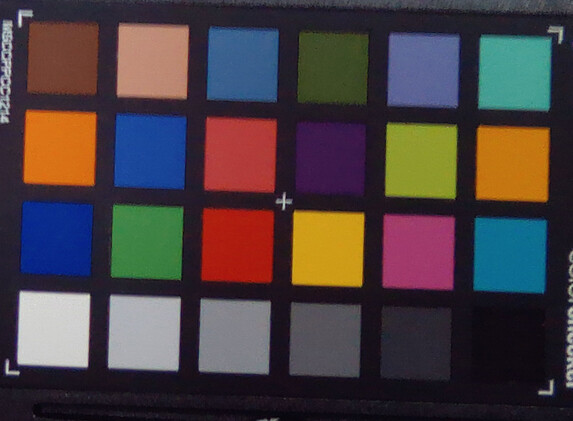
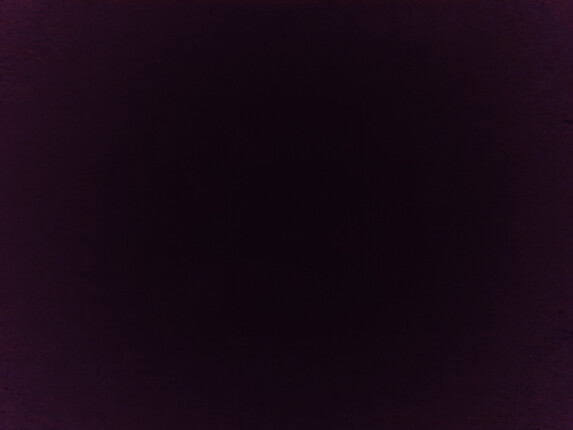
Accessories and Warranty - Folio cover included
The box of the Teclast P26T includes a 10-Watt charger (5V/2A), a USB cable, a folio cover, and some brief instructions. A SIM tool isn't included, but you won't need one since the microSD slot doesn't have a cover and is directly accessible.
Teclast offers a 12-month warranty on the P26T.
Input Devices and Operation - 2D face recognition needs a lot of light
The 16:10 touchscreen of the Teclast P26T implements inputs relatively speedily. But you will quickly notice during its operation that the Allwinner A523 isn't a performance champion. Even though it has access to 4 GB of RAM in the tablet, there are repeated small delays and wait times in everyday operation. At times, you also have to click some items a second time to get a response. Scroll gestures and other animations appear choppy with the 60-Hz refresh rate.
To unlock the tablet, besides a pattern, PIN, or password, you can also use 2D face recognition using the selfie camera. However, that really only works quickly and reliably if there is sufficient surrounding light. In our test, the camera won't recognize us anymore even in some slightly darker rooms when the shades are down, for example.
Display - Dark IPS panel with a color tint
The IPS panel of the Teclast P26T has a 1280x800 pixel resolution, which is quite low for the budget segment. This results in a pixel density of only 140 PPI for the 16:10 display, making the screen not very sharp. The display doesn't support HDR.
In terms of the remaining display parameters, the Teclast tablet also places at the bottom when it is compared against current devices in the same price class. With a white background, the maximum brightness of the IPS panel reaches up to 262 cd/m², while with an even distribution of light and dark image areas (APL18-measurement) the maximum is 258 cd/m². Some competitors such as the Blackview Tab 80 reach significantly higher values here.
The meager contrast ratio of 620:1 makes image content appear not very vibrant. In addition, the colors clearly have a blue tint, which further increases the bloodless image impression. On the other hand, pulse-width modulation (PWM) is not used, even in very low brightness settings, making the P26T very suitable even for users that are very sensitive to PWM.
| |||||||||||||||||||||||||
Brightness Distribution: 81 %
Center on Battery: 248 cd/m²
Contrast: 620:1 (Black: 0.4 cd/m²)
ΔE ColorChecker Calman: 8.62 | ∀{0.5-29.43 Ø4.79}
ΔE Greyscale Calman: 10.1 | ∀{0.09-98 Ø5}
83.2% sRGB (Calman 2D)
Gamma: 2.438
CCT: 10183 K
| Teclast P26T IPS, 1280x800, 10.1" | Blackview Tab 80 LCD, 1280x800, 10.1" | Lenovo Tab M10 Gen 3 IPS, 1920x1200, 10.1" | Teclast M50 HD IPS, 1920x1200, 10.1" | Samsung Galaxy Tab A7 LTE 2022 IPS, 2000x1200, 10.4" | Xiaomi Redmi Pad SE TFT-LCD, 1920x1200, 11" | |
|---|---|---|---|---|---|---|
| Screen | 48% | 36% | 13% | 20% | 74% | |
| Brightness middle (cd/m²) | 248 | 425 71% | 343 38% | 246 -1% | 322 30% | 473 91% |
| Brightness (cd/m²) | 236 | 423 79% | 332 41% | 227 -4% | 303 28% | 449 90% |
| Brightness Distribution (%) | 81 | 83 2% | 94 16% | 88 9% | 89 10% | 85 5% |
| Black Level * (cd/m²) | 0.4 | 0.4 -0% | 0.31 22% | 0.33 17% | 0.45 -13% | 0.28 30% |
| Contrast (:1) | 620 | 1063 71% | 1106 78% | 745 20% | 716 15% | 1689 172% |
| Colorchecker dE 2000 * | 8.62 | 5.11 41% | 5.9 32% | 6.28 27% | 7.02 19% | 3 65% |
| Colorchecker dE 2000 max. * | 17.81 | 9.8 45% | 11.2 37% | 14.1 21% | 10.38 42% | 6 66% |
| Greyscale dE 2000 * | 10.1 | 2.8 72% | 7.9 22% | 8.8 13% | 7.1 30% | 2.7 73% |
| Gamma | 2.438 90% | 2.183 101% | 2.184 101% | 2.277 97% | 2.179 101% | 2.27 97% |
| CCT | 10183 64% | 7136 91% | 9198 71% | 8024 81% | 8730 74% | 6589 99% |
* ... smaller is better
Screen Flickering / PWM (Pulse-Width Modulation)
| Screen flickering / PWM not detected | |||
In comparison: 53 % of all tested devices do not use PWM to dim the display. If PWM was detected, an average of 8152 (minimum: 5 - maximum: 343500) Hz was measured. | |||
Our tests with the Calman analysis software and spectral photometer show that the IPS panel reproduces colors very distorted, particularly overdoing it with blue and green color tones. In addition, the color space coverage is very low overall.
Display Response Times
| ↔ Response Time Black to White | ||
|---|---|---|
| 25.7 ms ... rise ↗ and fall ↘ combined | ↗ 12.6 ms rise | |
| ↘ 13.1 ms fall | ||
| The screen shows relatively slow response rates in our tests and may be too slow for gamers. In comparison, all tested devices range from 0.1 (minimum) to 240 (maximum) ms. » 61 % of all devices are better. This means that the measured response time is worse than the average of all tested devices (20.3 ms). | ||
| ↔ Response Time 50% Grey to 80% Grey | ||
| 60.2 ms ... rise ↗ and fall ↘ combined | ↗ 33.7 ms rise | |
| ↘ 26.5 ms fall | ||
| The screen shows slow response rates in our tests and will be unsatisfactory for gamers. In comparison, all tested devices range from 0.165 (minimum) to 636 (maximum) ms. » 96 % of all devices are better. This means that the measured response time is worse than the average of all tested devices (31.7 ms). | ||
With the low brightness of its IPS panel, the Teclast P26T is hardly suitable for outdoor use. Even under an overcast January sky, the contents are difficult to see on the display. This means that reading the screen contents would be even harder in summer, also in the shade. The viewing angles of the display are stable.
Performance - Allwinner SoC with few performance reserves
The Allwinner A523 processor keeps things running in the Teclast P26T. The entry-level octa-core SoC uses two quad-core clusters that a consist of 4 Cortex-A55 cores each. The faster quad-cluster runs at a clock speed of up to 1.8 GHz and the second at up to 1.4 GHz. The Allwinner A523 is accompanied by the ARM Mali-G57 MC1 as the graphics unit.
What can be seen in everyday operation is also confirmed by the benchmarks: The Allwinner A523 is not very powerful. The octa-core SoC makes the P26T a tablet with a speed that is below average even looking at budget criteria. But if the load you are placing on the 10.1-inch tablet isn't too high with very demanding apps, everything will run at a satisfactory speed most of the time.
| UL Procyon AI Inference for Android - Overall Score NNAPI | |
| Average of class Tablet (2597 - 76852, n=67, last 2 years) | |
| Xiaomi Redmi Pad SE | |
| Samsung Galaxy Tab A7 LTE 2022 | |
| Average Allwinner A523 (2757 - 2824, n=2) | |
| Teclast P26T | |
| Teclast M50 HD | |
| Blackview Tab 80 | |
| Lenovo Tab M10 Gen 3 | |
The ARM Mali-G57 MC1 helps the Teclast P26T to stand up better against the competitors than in the synthetic benchmarks. As the T-Rex benchmark from GFXBench shows, values around 30 frames per second are quite realistic while gaming. What mainly benefits the tablet here is its low display resolution of 1280x800 pixels, meaning that it has to compute significantly less pixels than many of its competitors.
GFXBench (DX / GLBenchmark) 2.7: T-Rex Onscreen | 1920x1080 T-Rex Offscreen
GFXBench 3.0: on screen Manhattan Onscreen OGL | 1920x1080 1080p Manhattan Offscreen
GFXBench 3.1: on screen Manhattan ES 3.1 Onscreen | 1920x1080 Manhattan ES 3.1 Offscreen
GFXBench: on screen Car Chase Onscreen | 1920x1080 Car Chase Offscreen | on screen Aztec Ruins High Tier Onscreen | 2560x1440 Aztec Ruins High Tier Offscreen | on screen Aztec Ruins Normal Tier Onscreen | 1920x1080 Aztec Ruins Normal Tier Offscreen | 3840x2160 4K Aztec Ruins High Tier Offscreen
| 3DMark / Wild Life Extreme Unlimited | |
| Samsung Galaxy Tab A7 LTE 2022 | |
| Teclast P26T | |
| Lenovo Tab M10 Gen 3 | |
| Xiaomi Redmi Pad SE | |
| Blackview Tab 80 | |
| Teclast M50 HD | |
| 3DMark / Wild Life Extreme | |
| Samsung Galaxy Tab A7 LTE 2022 | |
| Teclast P26T | |
| Lenovo Tab M10 Gen 3 | |
| Xiaomi Redmi Pad SE | |
| Blackview Tab 80 | |
| Teclast M50 HD | |
| 3DMark / Wild Life Unlimited Score | |
| Samsung Galaxy Tab A7 LTE 2022 | |
| Xiaomi Redmi Pad SE | |
| Lenovo Tab M10 Gen 3 | |
| Teclast P26T | |
| Blackview Tab 80 | |
| Teclast M50 HD | |
| 3DMark / Wild Life Score | |
| Samsung Galaxy Tab A7 LTE 2022 | |
| Xiaomi Redmi Pad SE | |
| Lenovo Tab M10 Gen 3 | |
| Teclast P26T | |
| Blackview Tab 80 | |
| Teclast M50 HD | |
| 3DMark / Sling Shot Extreme (ES 3.1) Unlimited | |
| Samsung Galaxy Tab A7 LTE 2022 | |
| Xiaomi Redmi Pad SE | |
| Lenovo Tab M10 Gen 3 | |
| Teclast P26T | |
| Blackview Tab 80 | |
| Teclast M50 HD | |
| 3DMark / Sling Shot Extreme (ES 3.1) Unlimited Graphics | |
| Samsung Galaxy Tab A7 LTE 2022 | |
| Xiaomi Redmi Pad SE | |
| Lenovo Tab M10 Gen 3 | |
| Teclast P26T | |
| Teclast M50 HD | |
| Blackview Tab 80 | |
| 3DMark / Sling Shot Extreme (ES 3.1) Unlimited Physics | |
| Samsung Galaxy Tab A7 LTE 2022 | |
| Lenovo Tab M10 Gen 3 | |
| Teclast M50 HD | |
| Blackview Tab 80 | |
| Xiaomi Redmi Pad SE | |
| Teclast P26T | |
| GFXBench (DX / GLBenchmark) 2.7 / T-Rex Onscreen | |
| Samsung Galaxy Tab A7 LTE 2022 | |
| Xiaomi Redmi Pad SE | |
| Blackview Tab 80 | |
| Lenovo Tab M10 Gen 3 | |
| Teclast P26T | |
| Teclast M50 HD | |
| GFXBench (DX / GLBenchmark) 2.7 / T-Rex Offscreen | |
| Samsung Galaxy Tab A7 LTE 2022 | |
| Xiaomi Redmi Pad SE | |
| Lenovo Tab M10 Gen 3 | |
| Teclast M50 HD | |
| Blackview Tab 80 | |
| Teclast P26T | |
| GFXBench 3.0 / Manhattan Onscreen OGL | |
| Blackview Tab 80 | |
| Samsung Galaxy Tab A7 LTE 2022 | |
| Xiaomi Redmi Pad SE | |
| Teclast P26T | |
| Lenovo Tab M10 Gen 3 | |
| Teclast M50 HD | |
| GFXBench 3.0 / 1080p Manhattan Offscreen | |
| Samsung Galaxy Tab A7 LTE 2022 | |
| Xiaomi Redmi Pad SE | |
| Lenovo Tab M10 Gen 3 | |
| Teclast P26T | |
| Teclast M50 HD | |
| Blackview Tab 80 | |
| GFXBench 3.1 / Manhattan ES 3.1 Onscreen | |
| Blackview Tab 80 | |
| Teclast P26T | |
| Samsung Galaxy Tab A7 LTE 2022 | |
| Xiaomi Redmi Pad SE | |
| Lenovo Tab M10 Gen 3 | |
| Teclast M50 HD | |
| GFXBench 3.1 / Manhattan ES 3.1 Offscreen | |
| Samsung Galaxy Tab A7 LTE 2022 | |
| Xiaomi Redmi Pad SE | |
| Lenovo Tab M10 Gen 3 | |
| Teclast P26T | |
| Teclast M50 HD | |
| Blackview Tab 80 | |
| GFXBench / Car Chase Onscreen | |
| Blackview Tab 80 | |
| Teclast P26T | |
| Samsung Galaxy Tab A7 LTE 2022 | |
| Xiaomi Redmi Pad SE | |
| Lenovo Tab M10 Gen 3 | |
| Teclast M50 HD | |
| GFXBench / Car Chase Offscreen | |
| Samsung Galaxy Tab A7 LTE 2022 | |
| Xiaomi Redmi Pad SE | |
| Lenovo Tab M10 Gen 3 | |
| Teclast P26T | |
| Blackview Tab 80 | |
| Teclast M50 HD | |
| GFXBench / Aztec Ruins High Tier Onscreen | |
| Teclast P26T | |
| Blackview Tab 80 | |
| Samsung Galaxy Tab A7 LTE 2022 | |
| Xiaomi Redmi Pad SE | |
| Lenovo Tab M10 Gen 3 | |
| Teclast M50 HD | |
| GFXBench / Aztec Ruins High Tier Offscreen | |
| Samsung Galaxy Tab A7 LTE 2022 | |
| Xiaomi Redmi Pad SE | |
| Lenovo Tab M10 Gen 3 | |
| Teclast P26T | |
| Blackview Tab 80 | |
| Teclast M50 HD | |
| GFXBench / Aztec Ruins Normal Tier Onscreen | |
| Teclast P26T | |
| Blackview Tab 80 | |
| Samsung Galaxy Tab A7 LTE 2022 | |
| Xiaomi Redmi Pad SE | |
| Lenovo Tab M10 Gen 3 | |
| Teclast M50 HD | |
| GFXBench / Aztec Ruins Normal Tier Offscreen | |
| Samsung Galaxy Tab A7 LTE 2022 | |
| Xiaomi Redmi Pad SE | |
| Lenovo Tab M10 Gen 3 | |
| Teclast P26T | |
| Teclast M50 HD | |
| Blackview Tab 80 | |
| GFXBench / 4K Aztec Ruins High Tier Offscreen | |
| Samsung Galaxy Tab A7 LTE 2022 | |
| Xiaomi Redmi Pad SE | |
| Lenovo Tab M10 Gen 3 | |
| Teclast P26T | |
| Teclast M50 HD | |
| Blackview Tab 80 | |
Web surfing usually works quickly and smooth with the P26T. However, the browser tests don't reflect this, since the P26T always finishes last here.
| Jetstream 2 - 2.0 Total Score | |
| Average of class Tablet (22.3 - 395, n=72, last 2 years) | |
| Xiaomi Redmi Pad SE (chrome 116) | |
| Teclast M50 HD (Chrome 120) | |
| Samsung Galaxy Tab A7 LTE 2022 (Chrome 112) | |
| Blackview Tab 80 (Chrome 120) | |
| Lenovo Tab M10 Gen 3 (Chrome 111) | |
| Average Allwinner A523 (22.3 - 26.9, n=2) | |
| Teclast P26T (Chrome 114.0.5735.60) | |
| WebXPRT 4 - Overall | |
| Average of class Tablet (26 - 376, n=76, last 2 years) | |
| Samsung Galaxy Tab A7 LTE 2022 (Chrome 112) | |
| Xiaomi Redmi Pad SE (chrome 116) | |
| Lenovo Tab M10 Gen 3 (Chrome 111) | |
| Teclast M50 HD (Chrome 120) | |
| Blackview Tab 80 (Chrome 120) | |
| Average Allwinner A523 (26 - 30, n=2) | |
| Teclast P26T (Chrome 114.0.5735.60) | |
| WebXPRT 3 - Overall | |
| Average of class Tablet (39 - 480, n=28, last 2 years) | |
| Samsung Galaxy Tab A7 LTE 2022 (Chrome 112) | |
| Xiaomi Redmi Pad SE (chrome 116) | |
| Blackview Tab 80 (Chrome 120) | |
| Teclast P26T (Chrome 114.0.5735.60) | |
| Average Allwinner A523 (n=1) | |
| Speedometer 2.0 - Result 2.0 | |
| Average of class Tablet (2.59 - 790, n=61, last 2 years) | |
| Xiaomi Redmi Pad SE (chrome 116) | |
| Teclast M50 HD (Chrome 120) | |
| Samsung Galaxy Tab A7 LTE 2022 (Chome 112) | |
| Blackview Tab 80 (Chrome 120) | |
| Lenovo Tab M10 Gen 3 (Chome 111) | |
| Average Allwinner A523 (19.8 - 21.8, n=2) | |
| Teclast P26T (Chrome 114.0.5735.60) | |
| Octane V2 - Total Score | |
| Average of class Tablet (763 - 138481, n=103, last 2 years) | |
| Xiaomi Redmi Pad SE (chrome 120) | |
| Samsung Galaxy Tab A7 LTE 2022 (Chrome 112) | |
| Teclast M50 HD (Chrome 120) | |
| Lenovo Tab M10 Gen 3 (Chrome 111) | |
| Blackview Tab 80 (Chrome 120) | |
| Average Allwinner A523 (5911 - 6314, n=2) | |
| Teclast P26T (Chrome 114.0.5735.60) | |
| Mozilla Kraken 1.1 - Total | |
| Average Allwinner A523 (8641 - 8772, n=2) | |
| Teclast P26T (Chrome 114.0.5735.60) | |
| Blackview Tab 80 (Chrome 120) | |
| Lenovo Tab M10 Gen 3 (Chrome 111) | |
| Teclast M50 HD (Chrome 120) | |
| Samsung Galaxy Tab A7 LTE 2022 (Chrome 112) | |
| Xiaomi Redmi Pad SE (chrome 116) | |
| Average of class Tablet (243 - 27101, n=85, last 2 years) | |
* ... smaller is better
The eMMC flash storage of the Teclast P26T is often encountered in this price class. It is not very fast and won't allow for short load times or high data throughput.
| Teclast P26T | Blackview Tab 80 | Lenovo Tab M10 Gen 3 | Teclast M50 HD | Samsung Galaxy Tab A7 LTE 2022 | Xiaomi Redmi Pad SE | Average 128 GB eMMC Flash | Average of class Tablet | |
|---|---|---|---|---|---|---|---|---|
| AndroBench 3-5 | 148% | 177% | 122% | 94% | 328% | 125% | 959% | |
| Sequential Read 256KB (MB/s) | 237.62 | 266.71 12% | 277.2 17% | 266.2 12% | 249 5% | 297.47 25% | 300 ? 26% | 1656 ? 597% |
| Sequential Write 256KB (MB/s) | 137.55 | 235.98 72% | 210.4 53% | 192.3 40% | 83 -40% | 228.97 66% | 195.1 ? 42% | 1213 ? 782% |
| Random Read 4KB (MB/s) | 63.08 | 65.11 3% | 105.1 67% | 70.4 12% | 67.3 7% | 102.41 62% | 85.9 ? 36% | 235 ? 273% |
| Random Write 4KB (MB/s) | 11.69 | 70.74 505% | 78.5 572% | 61 422% | 58.8 403% | 146.92 1157% | 58.1 ? 397% | 267 ? 2184% |
Games - PUBG Mobile comes close to the 30-FPS mark
When gaming, the Teclast P26T doesn't make a bad impression, particularly since the control via the touchscreen works well. But only graphically simple games such as Subway Surfers are displayed really smoothly. The brief drop you can see in its FPS chart below comes from opening up the menu and can therefore be ignored.
In more demanding games such as Asphalt 9 (in High graphics quality) or PUBG Mobile (HD/High setting), the P26T comes close to the 30 frames per second mark. However, there are also repeated significant drops in the frame rate with both games. Our impressions of the Asphalt 9 and PUBG Mobile games range between "stuttering" and "acceptable" overall.
We determine the game frame rates with our Gamebench test tool.
Emissions - A flat stereo sound from the Teclast P26T
Temperatures
The Teclast P26T hardly warms up during operation. On the surface, we measure a top value of 47.8 °C (118 °F) in the area of the cameras. But this value is only reached after the tablet was put under heavy load for an hour with the Burnout benchmark. In regular usage, the surface temperatures remain significantly lower than that.
The tablet is able to efficiently remove the heat of the Allwinner A523, as the Wild Life stress tests of 3DMark show. Even after the 20th run of the two test scenarios, the frame rates remain practically as high as during the beginning of the measurement.
(-) The maximum temperature on the upper side is 46.2 °C / 115 F, compared to the average of 33.7 °C / 93 F, ranging from 20.7 to 53.2 °C for the class Tablet.
(-) The bottom heats up to a maximum of 47.8 °C / 118 F, compared to the average of 33.2 °C / 92 F
(+) In idle usage, the average temperature for the upper side is 25.6 °C / 78 F, compared to the device average of 30 °C / 86 F.
3DMark Wild Life Stress Test
| 3DMark | |
| Wild Life Extreme Stress Test | |
| Samsung Galaxy Tab A7 LTE 2022 | |
| Teclast P26T | |
| Lenovo Tab M10 Gen 3 | |
| Xiaomi Redmi Pad SE | |
| Blackview Tab 80 | |
| Teclast M50 HD | |
| Wild Life Stress Test Stability | |
| Xiaomi Redmi Pad SE | |
| Samsung Galaxy Tab A7 LTE 2022 | |
| Lenovo Tab M10 Gen 3 | |
| Teclast M50 HD | |
| Teclast P26T | |
| Blackview Tab 80 | |
| Wild Life Unlimited Stress Test Stability | |
| Xiaomi Redmi Pad SE | |
Speakers
The two speakers of the P26T are both placed on the right short side, so you will only get a stereo effect if you hold the tablet in portrait orientation. Overall, the sound mix with its non-existent bass is not very balanced, making any music sound flat. Voices, on the other hand, sound very clear.
You can connect external audio devices using the 3.5-mm audio port or Bluetooth 5.2. The P26T supports the AAC, aptX, aptX HD, LDAC, and SBC Bluetooth audio codecs.
Teclast P26T audio analysis
(+) | speakers can play relatively loud (82.6 dB)
Bass 100 - 315 Hz
(-) | nearly no bass - on average 20.6% lower than median
(±) | linearity of bass is average (11.1% delta to prev. frequency)
Mids 400 - 2000 Hz
(±) | higher mids - on average 8.5% higher than median
(±) | linearity of mids is average (7.3% delta to prev. frequency)
Highs 2 - 16 kHz
(±) | higher highs - on average 7.7% higher than median
(±) | linearity of highs is average (9.6% delta to prev. frequency)
Overall 100 - 16.000 Hz
(±) | linearity of overall sound is average (26.3% difference to median)
Compared to same class
» 83% of all tested devices in this class were better, 4% similar, 13% worse
» The best had a delta of 7%, average was 21%, worst was 129%
Compared to all devices tested
» 80% of all tested devices were better, 4% similar, 16% worse
» The best had a delta of 4%, average was 24%, worst was 134%
Samsung Galaxy Tab A7 LTE 2022 audio analysis
(+) | speakers can play relatively loud (84.4 dB)
Bass 100 - 315 Hz
(-) | nearly no bass - on average 21.6% lower than median
(±) | linearity of bass is average (9.5% delta to prev. frequency)
Mids 400 - 2000 Hz
(+) | balanced mids - only 4.7% away from median
(+) | mids are linear (5.2% delta to prev. frequency)
Highs 2 - 16 kHz
(+) | balanced highs - only 4.6% away from median
(±) | linearity of highs is average (10.3% delta to prev. frequency)
Overall 100 - 16.000 Hz
(±) | linearity of overall sound is average (19% difference to median)
Compared to same class
» 52% of all tested devices in this class were better, 5% similar, 43% worse
» The best had a delta of 7%, average was 21%, worst was 129%
Compared to all devices tested
» 44% of all tested devices were better, 8% similar, 49% worse
» The best had a delta of 4%, average was 24%, worst was 134%
Power Management - A very short battery life and long charging time
Power Consumption
The Teclast tablet has a 6000-mAh battery that can be charged using the included 10-Watt charger. In our test, it takes 4:12 hours to completely recharge the tablet.
The power consumption of the P26T is inconspicuous with 1.3 watts during idle operation and 4.6 watts under load. But comparison devices such as the Blackview Tab 80 and Teclast M50 HD still run more efficiently.
| Off / Standby | |
| Idle | |
| Load |
|
Key:
min: | |
| Teclast P26T 6000 mAh | Blackview Tab 80 7680 mAh | Lenovo Tab M10 Gen 3 5100 mAh | Teclast M50 HD 6000 mAh | Samsung Galaxy Tab A7 LTE 2022 7040 mAh | Xiaomi Redmi Pad SE 8000 mAh | |
|---|---|---|---|---|---|---|
| Power Consumption | 26% | -53% | 10% | -14% | -98% | |
| Idle Minimum * (Watt) | 1 | 0.8 20% | 1.9 -90% | 1.2 -20% | 1.4 -40% | 0.63 37% |
| Idle Average * (Watt) | 1.3 | 1 23% | 2.1 -62% | 1.3 -0% | 1.6 -23% | 4.25 -227% |
| Idle Maximum * (Watt) | 1.7 | 1.5 12% | 2.5 -47% | 1.5 12% | 2 -18% | 4.34 -155% |
| Load Average * (Watt) | 4.6 | 3.2 30% | 7.6 -65% | 3.6 22% | 4.2 9% | 10.24 -123% |
| Load Maximum * (Watt) | 8.7 | 4.9 44% | 9 -3% | 5.5 37% | 8.7 -0% | 10.47 -20% |
* ... smaller is better
Power Consumption: Geekbench (150 cd/m²)
Power Consumption: GFXBench (150 cd/m²)
Battery Life
The battery life represents one of the largest weaknesses of the Teclast P26T. During simulated web surfing at an adjusted brightness of 150 cd/m², which corresponds to the 55% mark in the display settings, the tablet lasts less than 7 hours. When playing videos in a constant loop, it lasts about an hour longer. Under load, the battery is depleted after less than 3 hours.
With this, the Teclast P26T doesn't even come close to its competitors. Even the two "weakest" comparison devices last much longer. Despite having a smaller battery, the Lenovo Tab M10 Gen 3 lasts more than twice as long during web surfing, and the Teclast M50 HD reaches a good 7 hours when playing videos. The Teclast P26T also remains worlds apart from the Xiaomi Redmi Pad SE, which lasts significantly longer than 16 hours during both web surfing and playing videos.
| Teclast P26T 6000 mAh | Blackview Tab 80 7680 mAh | Lenovo Tab M10 Gen 3 5100 mAh | Teclast M50 HD 6000 mAh | Samsung Galaxy Tab A7 LTE 2022 7040 mAh | Xiaomi Redmi Pad SE 8000 mAh | |
|---|---|---|---|---|---|---|
| Battery runtime | 168% | 104% | 79% | 137% | 192% | |
| Reader / Idle (h) | 12.4 | 43.2 248% | 32.5 162% | 29.6 139% | 47.8 285% | 70.6 469% |
| H.264 (h) | 7.7 | 14.5 88% | 16.7 117% | 13.1 70% | 15.7 104% | 16.6 116% |
| WiFi v1.3 (h) | 6.7 | 16.9 152% | 14.4 115% | 11.1 66% | 14.6 118% | 17 154% |
| Load (h) | 3 | 8.5 183% | 3.6 20% | 4.2 40% | 4.2 40% | 3.9 30% |
Pros
Cons
Verdict on the Teclast P26T
The Teclast P26T is a solid entry-level tablet whose exterior doesn't show its 100-Euro (~$108) price. Its plastic case offers good workmanship and a good grip with the wavy texture on its back. The blue color of the case looks elegant. At 511 grams (~18 oz), the tablet weighs slightly more than many of its competitors, but it still doesn't feel too heavy when holding it in the hands for longer time periods.
However, you also have to accept a number of compromises in return for its low purchase price. As expected, the IPS display isn't the brightest and turns the P26T mainly into a tablet for indoors. It is also not surprising that the cameras aren't really good and the SoC hardly brings any performance reserves. But what might matter more is the fact that Teclast doesn't specify anything about the update policy for its tablet.
The Teclast P26T is a very affordable entry-level tablet with Android 13 that achieves its budget price through many compromises.
The two largest disadvantages of the P26T are its unstable and lame Wi-Fi 5 that gave us repeated connection problems during the test and the very short battery life. However, the WLAN problem could possibly be remedied by some future updates.
Alternatives to the Teclast P26T are the Blackview Tab 80 and the Lenovo Tab M10 Gen 3, for example. Both are similarly affordable but score with a faster and more stable WLAN and also a significantly better battery life. In addition, the IPS panel of the Blackview is fairly bright, and the Lenovo Tab offers a metal case. Both the Lenovo Tab M10 Gen 3 and the Blackview Tab 80 support LTE.
Price and Availability
The manufacturer lists the Teclast P26T for $99, referring to Amazon and AliExpress. However, both Amazon in the US and the UK show it as currently unavailable.
Teclast P26T
- 01/29/2024 v7 (old)
Manuel Masiero
Transparency
The selection of devices to be reviewed is made by our editorial team. The test sample was freely purchased by the author at his/her own expense. The lender had no influence on this review, nor did the manufacturer receive a copy of this review before publication. There was no obligation to publish this review. As an independent media company, Notebookcheck is not subjected to the authority of manufacturers, retailers or publishers.
This is how Notebookcheck is testing
Every year, Notebookcheck independently reviews hundreds of laptops and smartphones using standardized procedures to ensure that all results are comparable. We have continuously developed our test methods for around 20 years and set industry standards in the process. In our test labs, high-quality measuring equipment is utilized by experienced technicians and editors. These tests involve a multi-stage validation process. Our complex rating system is based on hundreds of well-founded measurements and benchmarks, which maintains objectivity. Further information on our test methods can be found here.




